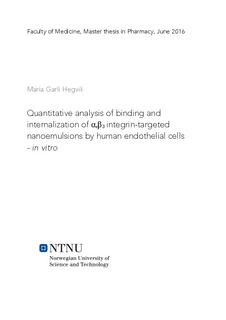| dc.description.abstract | The purpose of this master thesis was to quantitatively study the binding and internalization of αvβ3 integrin-targeted RGD-conjugated nanoemulsions (RGD-NE) by human umbilical vein endothelial cells (HUVEC) in vitro. The RGD-peptide sequence recognizes and binds specifically to αvβ3-integrins; receptors overexpressed in endothelial cells of angiogenic tumor vasculature and therefore a suitable target for nanomedicine. RGD-NE was fluorescently labeled with Rhodamine-PE to detect cellular uptake. αvβ3 integrin was stained with fluorescent-labeled antibodies to detect expression levels. Flow cytometry was utilized to quantitatively measure positive fluorescent HUVEC. Low density HUVEC (fast proliferating in lag phase) is expected to express high levels of αvβ3 integrins, while high density HUVEC (non-proliferating) is expected to express low levels. Targeting rates and levels are expected to correlate with integrin expression levels. Based on these expectations we investigated αvβ3 integrin expression and cellular uptake rates of RGDnanoemulsions as function of cell density. An achievement of a distinct low and high density within the same cell line would possibly enhance the in vitro model. Antibody staining experiments detected that the level of αvβ3 integrins decreases with increasing cell density, thus providing the possibility to study targeting as a function of expression levels of the target. RGD-NE incubation showed a correlation between increasing time between seeding and experiment (seeding regime) and decreasing cellular uptake of RGD-NE. When comparing 2, versus 4, versus 9 days between seeding of high density HUVEC, the uptake of RGD-NE decreases with increasing number of days from seeding to the day of experiment. Integrin levels were measured to be very similar when comparing these different seeding regimes, so these findings have to be more thoroughly investigated before making a final conclusion. In an attempt to characterize the binding of the RGD-NE in a more quantitative manner, saturation studies were performed to make an estimate of the dissociation constant (Kd), a measure of affinity binding. Preferably, the saturation binding studies should be performed at 4°C since the energy-dependent endocytosis will be inhibited and hence the result will reflect only bound and not internalized RGD-NE. The experimental set-up has to be further developed and optimized for a more reliable and significant result. | nb_NO |
